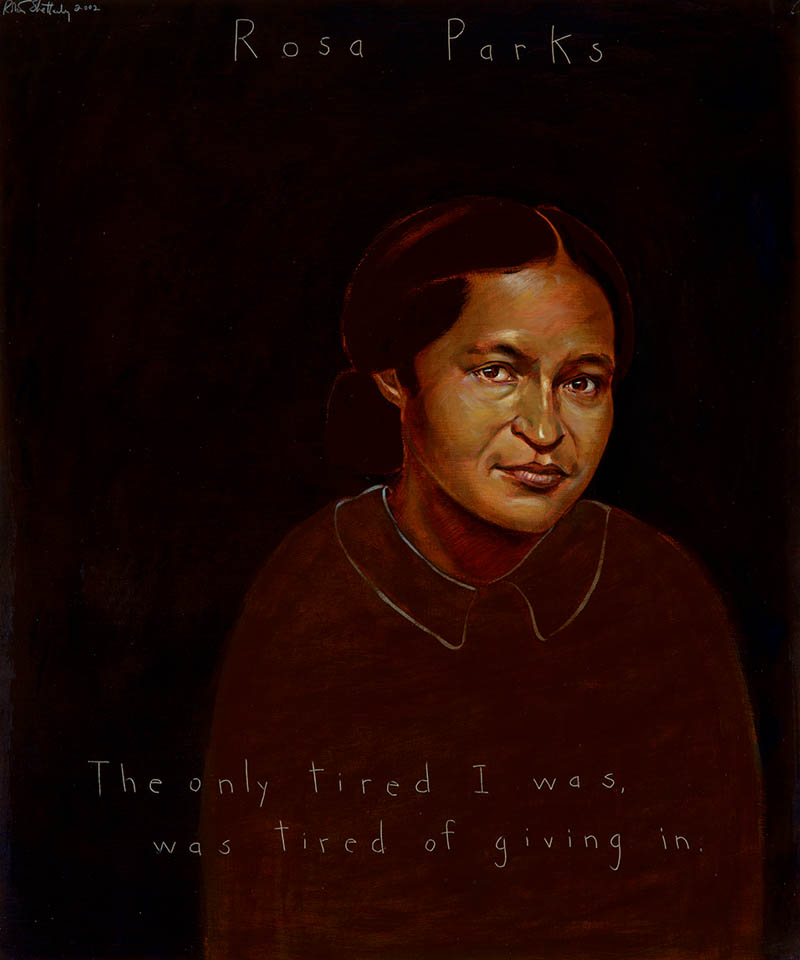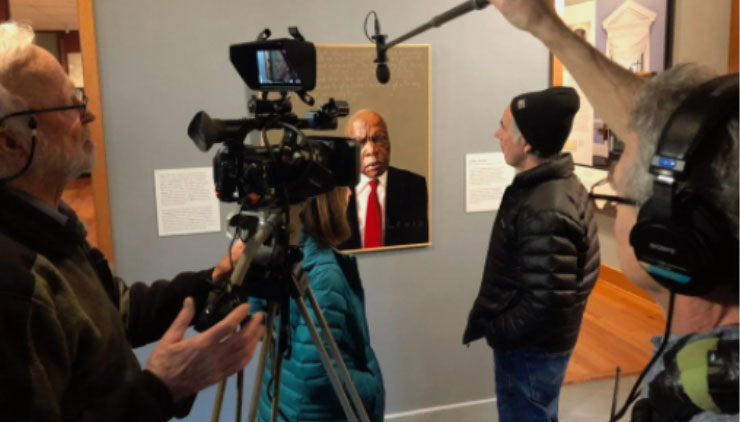
Rosa Parks
Seamstress, Civil Rights Leader : 1913 – 2005
“The only tired I was, was tired of giving in.”
Biography
Rosa Parks, the matriarch of the civil rights movement, has been described as an old woman who was too tired to give up her seat on a bus to a white person. However, Parks used her autobiography to correct the record. “I was not old, although some people have an image of me as being old then. I was forty-two.” She also made it clear that “the only tired I was, was tired of giving in.” Parks’s sentiment represented the view of the millions of African Americans, and their allies, who set out to end legal segregation in the mid-1900s.
Parks was born Rosa Louise McCauley, to James McCauley and Leona Edwards McCauley, in Tuskegee, Alabama, on February 4, 1913. Following her parents’ separation, Parks moved with her mother and younger brother to her maternal grandparents’ home in Pine Level, Alabama, just outside of Montgomery. She was educated at Montgomery’s Industrial School for Girls. At age sixteen, Parks suspended her studies to help support her family.
Though Parks was certainly aware of the daily injustices visited upon African Americans through Jim Crow segregation laws, she was not an early activist for racial equality. In 1932, she married Montgomery barber Raymond Parks who was active in the local NAACP chapter. With her husband’s encouragement, Parks completed her high school education in 1933. Parks worked as a seamstress at the Montgomery Fair department store. But it was through a job at Maxwell Air Force Base in Montgomery that Parks got her first taste of integration.
Parks did not join the NAACP until 1943, when she began serving as secretary to E.D. Nixon, who was the Montgomery chapter president from 1943 to 1957. As Nixon’s secretary, Parks had a front row seat to the various indignities faced by Montgomery’s African American community. In the summer of 1955, as Parks became more deeply committed to the civil rights struggle, she attended a training session at the Highlander Folk School (now the Highlander Center) in Monteagle, Tennessee; the Highlander Folk School, which began to train labor activists, served as a training ground for civil rights activists, including Martin Luther King, Jr. By year’s end, Parks was able to put to use some of the training she’d received in Monteagle.
On December 1, 1955, following her day of work at Montgomery Fair department store, Parks boarded a city bus and took her seat in the “colored” section. As the number of white passengers grew, the bus driver came to the “colored” section (which was determined with the use of a moveable sign placed in the aisle) to move the sign so as to increase the number of seats available to white passengers. It was at that point that Parks decided that she was not going to get up and move to a row behind her. The bus driver called the police, and Parks was arrested for violating Montgomery’s segregation laws.
By December 4, 1955, plans were in place for a one day boycott of the Montgomery city buses. Parks’s trial was December 5, the same day as the one day boycott; she was found guilty of disorderly conduct and violating Montgomery’s segregation law. The boycott, however, was an overwhelming success, because the vast majority of Montgomery’s African American community participated. It led to the creation of the Montgomery Improvement Association (MIA), and a young Martin Luther King, Jr., was elected as the association’s president. Ultimately, the MIA extended the boycott and the the African American community of Montgomery stayed off city buses until December 20, 1956, following the U.S. Supreme Court ruling in Browder v. Gayle, which affirmed a lower court’s ruling that segregated seating on public buses was unconstitutional.
Parks’s arrest took a toll on the Parks family; both Rosa and Raymond Parks ended up unemployed (through a firing and a resignation, respectively). The Parks left Montgomery for Hampton, Virginia in 1957, and then relocated permanently to Detroit, Michigan, where Parks found work as a seamstress. However, following the election of John Conyers to the U.S. House of Representatives, Parks was offered a position as receptionist and secretary in Conyers’ Detroit office. Parks remained with the congressman’s office until her retirement in 1988.
In 1980, following the deaths of her husband (1977), brother (1977) and mother (1979), Parks, along with The Detroit News, and the Detroit Public school system, founded the Rosa L. Parks Scholarship Foundation. Parks also co-founded, with Elaine Steele, the Rosa and Raymond Parks Institute for Self Development in 1987. Both organizations remain active, and continue to uphold the legacy of Parks.
Parks’s place in the history of the civil rights movement has been recognized and honored by the nation. She was awarded the Presidential Medal of Freedom in 1996, as well as the Congressional Gold Medal in 1999, for her role in the civil rights movement.
At the age of ninety-two, she passed away in Detroit. President George W. Bush ordered all U.S. flags to be flown at half-staff in her honor. Parks was also given the honor of lying in state in the rotunda of the U.S. Capitol. She was the first woman and the second African American to lie in state. On February 27, 2013, a statue of Parks was unveiled in the National Statuary Hall in the U.S. Capitol; that statue had been requested by President Bush on December 1, 2005, the 50th anniversary of Parks’s arrest.
Programs
Americans Who Tell the Truth (AWTT) offers a variety of ways to engage with its portraits and portrait subjects. Host an exhibit, use our free lesson plans and educational programs, or engage with a member of the AWTT team or portrait subjects.

Education
AWTT has educational materials and lesson plans that ask students to grapple with truth, justice, and freedom.

Exhibits & Community Engagement
AWTT encourages community engagement programs and exhibits accompanied by public events that stimulate dialogue around citizenship, education, and activism.